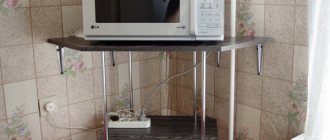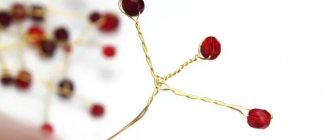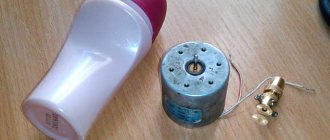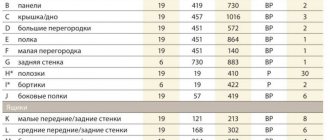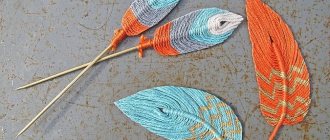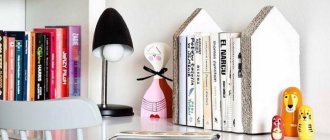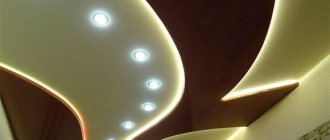Home/Design and interior/Do-it-yourself invisible shelf made from books: Materials, tools and manufacturing rules
A decorative book shelf is considered not just an excellent, but also a very creative idea. But unlike all shelves, the fastening itself is not noticeable here. Thus, it seems as if the books are simply floating in the air.
Such solutions will allow you to bring a zest to your home that all guests will appreciate and will be indescribably delighted. The most important thing is to read the detailed instructions to do everything correctly at all stages.
Materials and tools
In order to create a unique book shelf, you will need a minimum amount of materials and tools, so the costs will be insignificant:
- A book with a hard cover (it is advisable to choose a thick book);
- Bracket (can be purchased at any hardware store);
- Screws with washers;
- Dowels for the bracket that will attach it to the wall;
- Drill;
- Screwdriver.
Finding everything you need will not be difficult, so the installation procedure will be quick and easy.
Creation algorithm
- To make hidden shelves with your own hands, first draw a sketch; this will help you understand the design and find out what type and size of wood is needed. The step also includes measuring the width of the space from wall to wall.
- The next step is to create a special frame. You can use liquid nails to glue the frame together first, and then use screws and angle iron to hold all the pieces together.
- Next, the boards are painted or painted, which will then be fixed to the frame. You can use the same paint or varnish that has already been used on other furniture. It's nice that today there are varnishes available that will make wood look old in a matter of minutes and highlight its texture, such a finish is great for a rustic style.
- The desired height of future shelves is measured and the support frames are attached to the wall. Before drilling, the wall is checked using a detector for the presence of wires and pipes.
- Next, you need to make sure that the invisible shelf is level. After all, it is quite difficult to find beautiful boards that are quite straight. If it turns out that the boards are uneven, proceed to step 6.
- Spacers are added to level the shelf. This step is repeated for the top and bottom boards.
- Then the top board is glued to the frame using liquid nails.
- The bottom board is much more difficult to fix with liquid nails, so it is better to secure it with screws.
- The front part of the shelf is glued last.
Attention! The walls of the room are painted before attaching the shelves. Instead of boards, you can use MDF.
Manufacturing
Now all that remains is to mount everything. The main thing is to follow strict instructions, in which there is nothing complicated:
- Open the book to about a third of its thickness.
- We insert the bracket with the wide side.
- We fasten the back of the book to the bracket using bolts.
- On the reverse side of each bolt we secure it with a nut for secure fixation.
- This way you will get a book from which the bracket will stick out. Of course, it will be a little noticeable from the side, but if you look at the end of such a unique shelf, you will get the impression that the book is simply floating in the air.
- Now, using a dowel, you need to secure the other side of the bracket to the wall. It is best to use an impact drill for this so that you can easily go through the hard concrete base.
- That's it, now the shelf is ready for use. To hide the bracket, which is attached to the wall, you can put several more publications on top of the first book.
Bookshelves floating in the air
Every book lover is incredibly proud of his personal library, even if it does not have many copies. Glass cabinets are usually reserved for storing especially valuable rarities, but those volumes that are especially dear to the heart and pleasing to the eye are usually carefully placed on bookshelves.
There are a great many ideas on how to effectively and practically arrange books in the interior. To the delight of avid readers, designers are tirelessly developing more and more original and convenient devices: mobile organizers, hanging boxes, wall modules, ladders with drawers, tables and chairs with built-in shelves, and today there are countless modifications of all kinds of holders.
The “invisible” shelves look especially unusual: their entire frame is hidden behind a stack of books, which creates the illusion of complete weightlessness.
What is good about an invisible shelf:
- You don’t have to burden your space with bulky shelving;
- The accessory is a great space saver and fits seamlessly into any interior style. Hidden shelves would be equally appropriate in the living room and bedroom;
- the structure turns out to be very strong, but itself has a fairly light weight - only 395 grams;
- the platform is closely adjacent to the wall and is completely masked by literary publications. It seems as if the volumes “hovered” magically in the air;
- the metal holder has great endurance: the total weight can reach 7-8 kilograms, which is equivalent to a dozen rather weighty books;
- The shelves can be fixed in any way you like - lined up one after another, hung in a checkerboard pattern, or, for example, assembled in the form of a snake.
For reliable installation of the structure, several steel screws are provided. At the bottom of the shelf there are miniature latches that hold the book without the risk of damaging the cover.
An “invisible” shelf is a gift worthy not only of an ardent book lover, but also of any extravagant nature: it will reflect an exquisite sense of style, commitment to fashion trends, and the ability to correctly place decorative accents. By placing your collection at the epicenter of everyone's attention, you will demonstrate your individual taste, temperament, area of personal interests and, of course, high erudition!
Invisible shelf for heavy loads
This option is more reliable and is suitable in cases where people are going to place a lot more books on such a shelf. According to the installation principle, the design is not very different from its predecessor, but due to circumstances, an unlimited number of books can be placed on such a shelf. More precisely, you can stack as many books as you can fit to the beginning of the ceiling.
What influences the choice of fastening
There are different options for hidden fasteners, which differ in price, type, shape and other characteristics. In any case, when using this method of fixing structures, you need to consider the following points:
- Wall thickness. This indicator is especially important when it comes to pin fastening. It can be used only if the thickness of the concrete wall is 10 cm or more, the thickness of the brick wall is from 25 cm. For bases that do not meet these parameters, it is better to choose a different type of invisible fastening or use additional fittings. If you do not strengthen the fasteners, then only the lightest items can be stored on the shelf - a couple of jars of cosmetics, jewelry.
- Shelf thickness. For small loads, it is enough to install a product 3 cm thick; for heavier items, you will have to buy shelves 4.5-6 cm thick. It is important that the structure is strong, solid, with a flat surface.
The number of fittings also needs to be thought out in advance. For shelves shorter than 1 meter, only two fasteners are sufficient.
Important! If the length of the product is longer, you must add fasteners - this will allow you to evenly distribute the load.
Materials and tools
Here everything can be found in almost every home, so you don’t have to spend a lot of time searching.
- Hardback;
- Two brackets of the same length;
- Four screws with nuts;
- Four dowels;
- Drill;
- Screwdriver;
- Pencil or pen (useful for accurately marking holes);
- Building level (needed to ensure that the shelf is in a perfect horizontal plane).
Of course, you will have to purchase some materials, but in general, the cost of making an invisible shelf will be minimal.
Types of fastenings
Shelf mounts are selected taking into account the weight, design features and material used to manufacture this interior element, as well as the type of surface on which they will be installed.
Types of fastening shelves to the wall differ in structure, design, method of fixation and support. The most popular type is visible fittings, usually brackets. They are the easiest to install, can withstand the heaviest loads, and provide reliable support.
Attaching shelves to the wall without visible fasteners is more difficult. In addition, this option is not suitable for all walls - a solid base is required: concrete, brick.
Some structures, for example, gypsum plasterboard partitions, must be thick enough to allow shelves to be hung on them in this way.
Installation
The installation procedure is not much different from the first option, although there are some subtleties here too. First you need to place the brackets so that they are in the same plane. On the wall, using a pencil, you need to mark the places for the dowels, so that later you can immediately drill the holes needed for the fastenings.
After the holes for the bracket are drilled in the wall, you can begin installing the mounts on the book.
It is enough to place the brackets almost immediately under the cover and secure them with bolts and nuts.
Now the entire structure is mounted on the wall and securely fixed with dowels.
Thanks to such strong fastenings, the shelf can withstand quite a significant weight.
AlinaAuthor of the article
Did you like the article?
Share with your friends:
How to fix the bracket
After the nests are ready, the bracket for making the invisible shelf needs to be secured to the book. To do this, it is first inserted into the cut grooves and pressed tightly against the book with your hand. Next, insert the drill bit into the holes in the bracket and turn on the tool.
The book should be drilled through its entire thickness. Thread screws into the resulting holes, through the bracket and the book and screw them in with nuts, using wide sealing gaskets.
To prevent the book from opening when used as a stand, at the next stage two more holes are drilled through its thickness along the edges at an equal distance from the edges of the pages. In this case, fastening is also done using screws.
Features of fastening shelves depending on the type of wall
When installing fasteners for shelves to the wall, you should take into account the characteristics of the material from which the base is made. The higher its strength, the more securely the hinged structure will be fixed. Soft wood and brittle plasterboard surfaces are not capable of providing quality support. The methods for attaching shelves to them and the type of fittings used differ.
Furniture corner
This type of fastening is used to connect two parts. This is a rather fragile connection method, so it is used for fastening parts that should not be subject to heavy loads. Usually these are decorative elements, for example, the base of a cabinet or mezzanine shelves.
Figure 21. The furniture corner is used for fastening decorative furniture elements (plinths) and installing shelves. Made of plastic. Has a cover to hide the clasps. Self-tapping screws 16 mm long are used as fasteners.
Instead of metal corners, plastic ones are often used. They are no less durable, but have a more attractive appearance and the possibility of hidden fasteners. The corner of the cabinet is attached to two mating parts with two self-tapping screws. The lid is then suspended, thereby hiding the fasteners.
Figure 22. The corner of the cabinet is used for fastening lightly loaded furniture elements, as well as for installing decorative elements such as plinths, inserts, etc.
The furniture fasteners discussed in the article are the most common and frequently used, as they are the most versatile and easy-to-use types of fasteners. In the vast majority of cases, the types of furniture fastenings described are sufficient for assembling any furniture.
